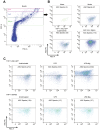FACS-based detection of extracellular ASC specks from NLRP3 inflammasomes in inflammatory diseases
- PMID: 39657685
- PMCID: PMC11754646
- DOI: 10.1093/cei/uxae117
FACS-based detection of extracellular ASC specks from NLRP3 inflammasomes in inflammatory diseases
Abstract
Introduction: The apoptosis-associated speck-like protein containing a caspase recruitment domain (ASC) is crucial for inflammasome assembly and activation of several inflammasomes, including NLRP3. ASC aggregates are detected in human sera post pyroptotic cell death, but their inflammasome origin remains unclear.
Method: This study aimed to develop a method to detect ASC aggregates originating from NLRP3 inflammasomes. Initially, human monocytes, macrophages, and THP-1 ASC reporter cells were employed to validate the detection of ASC/NLRP3-positive events through flow cytometry.
Results: The presence of ASC/NLRP3 specks was confirmed in cell supernatants from monocytes and macrophages treated with LPS and nigericin or ATP. Flow cytometry analysis identified double-positive specks in patient sera from inflammatory conditions when compared with healthy controls. Elevated ASC/NLRP3 specks were observed in conditions such as cryopyrin-associated periodic syndrome and Schnitzler's syndrome.
Conclusion: We validated fluorescence-activated cell sorting as a reliable method for detecting ASC/NLRP3 specks in human sera, with potential diagnostic and monitoring applications in certain systemic autoinflammatory diseases.
Keywords: ASC; NLRP3; SAID; inflammasome; inflammation.
© The Author(s) 2024. Published by Oxford University Press on behalf of the British Society for Immunology.
Conflict of interest statement
S.S. received honoraria for participation in advisory board meetings and speaking engagements, travel support, and research grants from SOBI and Novartis. Other authors have no conflicts of interest to declare.
Figures






References
-
- Broz P, Dixit VM.. Inflammasomes: mechanism of assembly, regulation and signalling. Nat Rev Immunol 2016, 16, 407–20. doi: https://doi.org/10.1038/nri.2016.58 - DOI - PubMed
-
- Cheng J, Waite AL, Tkaczyk ER, Ke K, Richards N, Hunt AJ, et al. Kinetic properties of ASC protein aggregation in epithelial cells. J Cell Physiol 2010, 222, 738–47. doi: https://doi.org/10.1002/jcp.22005 - DOI - PMC - PubMed
-
- Hoss F, Rodriguez-Alcazar JF, Latz E.. Assembly and regulation of ASC specks. Cell Mol Life Sci 2017, 74, 1211–29. doi: https://doi.org/10.1007/s00018-016-2396-6 - DOI - PMC - PubMed
-
- Lara-Reyna S, Caseley EA, Topping J, Rodrigues F, Jimenez Macias J, Lawler SE, et al. Inflammasome activation: from molecular mechanisms to autoinflammation. Clin Transl Immunol 2022, 11, e1404. doi: https://doi.org/10.1002/cti2.1404 - DOI - PMC - PubMed
-
- Franklin BS, Bossaller L, De Nardo D, Ratter JM, Stutz A, Engels G, et al. The adaptor ASC has extracellular and ‘prionoid’ activities that propagate inflammation. Nat Immunol 2014, 15, 727–37. doi: https://doi.org/10.1038/ni.2913 - DOI - PMC - PubMed
MeSH terms
Substances
Grants and funding
LinkOut - more resources
Full Text Sources
Miscellaneous

